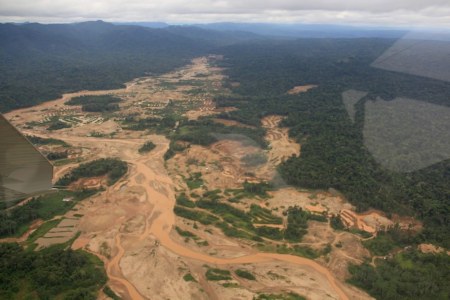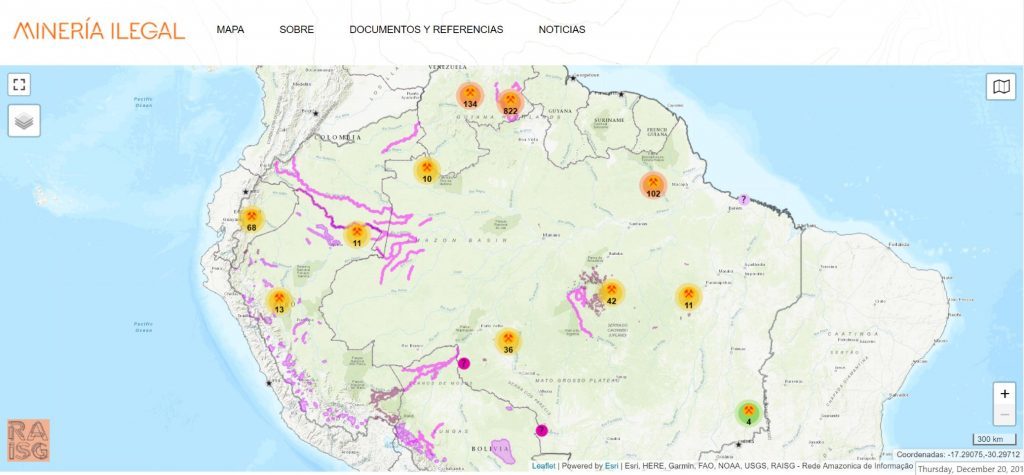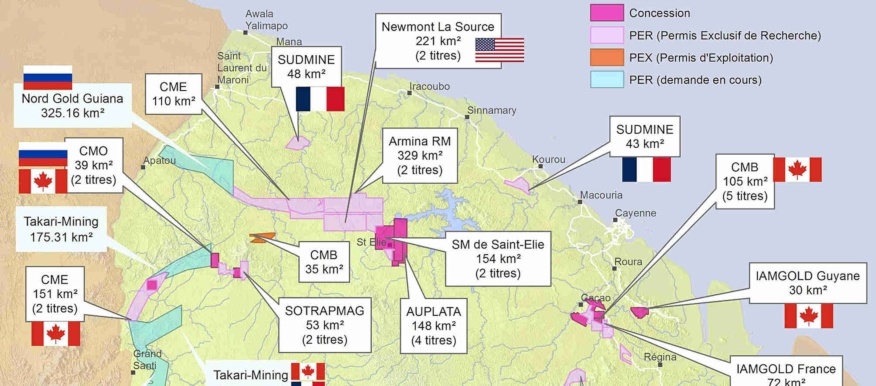
Views: 48
The use of mercury in the Continental Amazon dates back to the pre-colonial era and exponential accumulation in rivers is a growing threat to riverine fauna and communities.
Minapim by Hernan Valenzuela: A study by Colin A. Cooke concludes that 1400 BC, in the emergence of complex Andean societies, the region served as a locus for the early extraction of mercury (Hg). The oldest mining targeted cinnabar (HgS) for the production of vermilion, for painting. During this period, mercury in the Amazon could be less intensively used by local tribes, since it was not a commercial product. Considered by the Indians as an ornament, gold has a commercial purpose for the Spanish Settlers.
The settlers descended the Andes, carried mercury leather bags for mining, and after being emptied they were used to transport gold to Spain. (According to Hamilton, since 1503 and over the next 160 years, 181 tons of gold and 16,900 tons of silver have arrived from Spanish America)
If we consider that in artisanal mining two kilos of mercury are used for each kilo of gold, we could deduce that only at the time of the colony approximately 362 tons of mercury were dumped into the rivers of America and that was only the beginning.
The coveted El Dorado might have been in the Amazon jungle, but wherever it was, gold today is in various parts of the continental Amazon. The countries that share this vast green territory have legal and illegal mining activities.
Legal mining activities are typically carried out by large companies, using technology that allows the use of mercury and 99.9% reuse (estimated). In illegal artisanal mining, recovered mercury can only reach 30%, so that 70% of the mercury is in the environment either in gas or liquid form in rivers.

According to RAISG, today the continental Amazon has 1254 illegal mines distributed this way Venezuela 956 – Brazil 205 – Peru 25 – Ecuador 68, mines are also reported in the Bolivian Amazon, Suriname and French Guiana (not counted).
The continental Amazon region, according to the Biomes Organization, has shown a worrying evolution in terms of mining areas.
The Mining Areas accounted for in 1985 were 1332,768261 hectares. In the last data collected in 2017, the total area was 14441,448,608 hectares, indicating an increase of 1087.72% over 32 years on an average of 33.99% per year.
This contamination becomes a nightmare, as it affects the fish in the rivers, the entry of mercury through the trophic chain is of concern, especially in places where fish are the staple food of the riverine. As an example piscivorous specimens such as bentón (Hoplias malabaricus), or surubis (Pseudoplatystoma) and red piranha (Pygocentrus nattereri), are those that concentrate the largest amounts of mercury.
Two natural processes favor increased mercury concentrations in fish: bioaccumulation and biomagnification. The first is a process of gradual deposition of a chemical into the body of a living being, because the product is absorbed faster than it can be expelled from the body. And the second, bio-magnification, which is a process of accumulation of some chemicals off the food chain. “The bigger the fish, the more mercury, because they ate another fish and this one smaller”,
For humans exposure to mercury before birth and in childhood can cause mental retardation, cerebral palsy, deafness and blindness. Scientific evidence states that small doses can cause attention deficit and learning problems.
The situation in each country of the Continental Amazon and members of the Amazon Cooperation Treaty
(TCA) signed in 1978 by Bolivia, Brazil, Colombia, Ecuador, French Guiana, Peru, Suriname and Venezuela
Colombia
Here we found an exemplary initiative for the various countries of the Amazon; on July 16, 2018, it was in history as the day that Colombia officially banned the use of mercury in mining, just as it was already established in law 1658 of 2013. It was determined that in five years (2018) the use of this would be prohibited. element in all extractive activity, especially gold, one that uses bad mercury and that, by 2023, industry and all productive processes in the country should eliminate mercury from its activities.
Brazil
Brazil, of all Amazonian countries, probably has the most elaborate set of policies and regulations regarding small-scale gold mining. However, most small-scale miners continue to work without the necessary environmental and mining permits. As a result, the sector continues to be associated with environmental damage and health risks, while providing a livelihood alternative for thousands of individuals in Brazil’s poorest regions.
French Guiana

The legal exploitation of gold is officially 183kms², with research permission 1,701 kms². Recently an area of 1,250 km² of potential extraction was listed; the ongoing project is at the height of discussion: Exploration would mean an open pit 2.5 kilometers long, 500 meters wide and 400 meters deep. The consortium of Russian-Canadian companies wants to open a giant hole in the jungle of French Guiana. They would extract 400 million cubic meters of soil by grinding the rock and processing it with cyanide and other highly toxic chemicals to obtain the gold.
The project was born in 2014 with the multinationals Nordgold and Columbus Gold is known as Montagne d’Or or “Golden Mountain”. It was estimated that 167 tons of precious metal could be extracted. In 2017, a first company-funded feasibility study was completed positively and the first procedures were carried out.
The Montagne d’or project is currently “incompatible with an ecological ambition,” Emmanuel Macron said on Monday, May 6, 2019 at the Elysium after receiving a delegation of scientists from the Intergovernmental Biodiversity and Services Platform. of Ecosystems (IPBES).
Suriname

Suriname’s vast, ancient rainforests remain one of the best kept natural secrets in the world, but the global demand for an ancient mineral threatens to destroy them. Record high gold prices over the past decade have sparked a huge gold rush across the country and the wider Amazon, resulting in the destruction of thousands of hectares of rainforests and the contamination of major rivers with highly toxic materials.
Ecuador
With 68 illegal miners under RAISG, mining concessions in sensitive areas do not stop. Indigenous and peasant communities face non-compliance with prior consultations, accumulating environmental damage in their territories. In the Kutuku Shaimi Protective Forest in the Ecuadorian Amazon alone, 42 concessions, equivalent to 200,000 hectares, were granted.
Bolivia
The President signs Supreme Decree 26075 on Permanent Forest Production Lands and clears agricultural activities on private and community lands, and authorizes controlled burning. 4 million hectares of the Amazon.
A government study indicates that 70 percent of Bolivia’s 133 tons of mercury per year comes from gold mining.
In 2016, a scientific study conducted on ten rivers in the Bolivian Amazon confirmed that several fish species are contaminated with mercury.
A 2014 Cedib study estimated that there were between 600 and 800 rafts of gold miners exploring the Madre de Dios River, although only 413 were authorized. Each raft used between 500 and 1000 grams of mercury per day.
The Bolivian government estimates that gold production accounts for 47% of mercury emissions, according to the book “Mercury in Bolivia: Baseline Emissions and Uses of Pollution”
Peru:
According to the Ong Artisanal Gold Council, over 180 tons of mercury is discharged annually into the soil, air and water in Madre de Dios. According to the World Mercury Observatory, over 150 tons per year is already worrying.
Venezuela
Nicolás Maduro approved Mining Development Plan 2016-2018, which reserves the state gold mining activities.
With 960 illegal mines, the opening of the Orinoco Mining Arch begins to have harmful effects, not only with the increase of delinquency and the destruction of indigenous culture: the riverside communities in Bolivar State have high rates of mercury in blood, hair and humans tissue.
This picture in the Venezuelan Amazon came after the concession to Canadian company Crystallex, which operated the Las Cristinas field in the state of Bolivar, ended. His 2003 report found reserves of over 453 tons of gold with a shelf life of 34 years. Therefore, the price was $ 114.64 per kilo. The concession was awarded in 2011 to two Russian companies, through the control of state-owned company Minerven. The price of gold has risen to over $ 482 per kilo.
Awareness is the way
The above data show that the documents signed by the countries do not materialize in effective actions, we could summarize that there are few exceptions regarding the preservation of the Amazon, which suggests that the media in general may be misinforming and manipulating the population in search of profit. political or defending commercial interests, as only trying to show a culprit for damage created by all. Scientific evidence shows that even those with technology and resources to protect the Amazon do not take effective action to do so.
Mercury contamination harms the environment and endangers the inhabitants of the Continental Amazon rainforest. TCA (1978): Bolivia, Brazil, Colombia, Ecuador, French Guiana, Peru, Suriname and Venezuela.
Our home is the planet, the forest belongs to every resident and every country listed above, so the concern should be everyone’s concern. If we contaminate the rivers we are also contaminating the sea, and it is good to remember that the greatest danger to humanity may come from the sea !!
Related Article: Breaching a “carbon threshold” could lead to mass extinction
Mercury Amazon
Additional information: Mercury Amazon
The Amazonia presented in this publication is a region of high socio-environmental diversity undergoing rapid change. It covers a total of 7.8 million km2, around 12 macro-basins and 158 sub-basins, administrated by 1497 municipalities, 68 departments/states/provinces in eight countries: Bolivia (6.2%), Brazil (64.3%), Colombia (6.2%), Ecuador (1.5%), Guyana (2.8%), Peru (10.1%), Suriname (2.1%) and Venezuela (5.8%), as well as French Guiana (1.1%). Amazonia is home to around 33 million people, including 385 indigenous peoples, some of them living in ‘isolation.’ There are 610 PNAs and 2344 ILs, occupying 45% of Amazonia’s land surface, not including the owners of small, medium and large rural properties, companies of various kinds, and research and development institutions, as well as religious and civil society organizations.
Sources: Mercury Amazon
- Consolidated base with the sources information:
- Bolivia: FAN, CEDIB based on SERGETECMIN, 2013;
- Brazil: DNPM, Jan / 2018; Colombia: Catastro Minero Colombiano, 2017;
- Ecuador: ARCOM, 2018;
- Guyane Française: DEAL – Mining,
- Guyana: Geology and Mines Commission, 2009;
- Peru: INGEMMET, marzo / 2018;
- Suriname: Natural Resource and Environmental Assesment-NARENA;
- Venezuela: Ministry of Energy and Mines, 2009, Official Gazette No. 426,514, 2016;
Other Sources:
- https://www.pnas.org/content/106/22/8830 Colin A. Cooke,
- http://www.grida.no/resources/5026
- http://mapbiomas.org/stats
- https://raisg.socioambiental.org/
- https://es.mongabay.com/2019/07/bolivia-polemica-norma-en-la-amazonia/
- https://www.amazoniasocioambiental.org/es/radar/mercurio-en-latinoamerica-6-reportajes-sobre-los-efectos-de-la-mineria/
- https://es.mongabay.com/2017/11/bolivia-indigenas-campesinos-expuestos-al-mercurio-consumo-peces-la-amazonia/
- https://es.mongabay.com/2019/07/jessica-pisconte-guardaparque-peru-tambopata/
- https://es.mongabay.com/2016/01/mineria-de-oro-en-venezuela-una-tormenta-perfecta-de-mineria-ilegal-deforestacion-y-mafias/
- https://www.amazonteam.org/launch-of-amazonia-atlas-amazonia-under-pressure/
- Small-scale Gold Mining in the Amazon. https://www.gomiam.org/wp-content/uploads/2014/11/20130312-Cuaderno-Small-Scale-Gold-Mining-in-the-Amazon.pdf
Leave a Reply